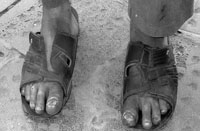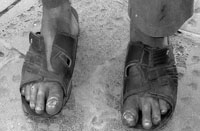
East and WestEaster weekWould Van Gogh paint the prodigal’s feet? [Archives:2005/826/Opinion]
March 21 2005
 |
Email: 140765@ sympatico.ca
I wonder if the prodigal son had blistered feet. And I wonder if Vincent Van Gogh, if he were alive, would come to Yemen to paint them.
You know the parable of the prodigal, as told by Jesus the Messiah. A young man abandons home, taking his inheritance early. He lives wildly, then winds up alone and broke and eating in the company of pigs. When he finally returns home, hoping to be just a hired-hand, his lovesick father runs, ridiculously, likely almost tripping on his thobe, to meet him in the distance. He throws his arms around his son. And he kills the fattened calf and throws a party.
Universal story
It's a universal story. American writer Ernest Hemingway tells it well in The Capitol of the World while writing about a runaway teenage son. After a lengthy search, the longing father buys a Madrid newspaper ad. “Dear Paco, Meet me in front of the newspaper office tomorrow at noon. All is forgiven. I love you.” The next day 800 men named Paco are at the office wanting to restore a broken relationship.
It's Dutch painter Rembrandt who painted a scene of the prodigal being held in his father's arms. The painting has such impact, Catholic priest and scholar Henri Nouwen once traveled to St. Petersburg, Russia just to see the original. He stood in front of it for four hours, then noted it shows humanity's “yearning for a lasting home.”
Vincent Van Gogh, who, like Rembrandt, was Dutch, painted similar themes. I'm reminded of this whenever I drive the dusty and busy streets of Yemen and slip the song “Vincent,” by singer Don McLean, into my tape-deck. The lyrics explain how Vincent painted “weathered faces lined in pain.” He put “frames around ragged men in ragged clothes.” He “tried to set them free.”
I find the imagery especially powerful here, because, as you know, Yemeni feet are not Paris feet. They are not London feet, or New York feet, or even Toronto feet. Westerners visiting here are always interested to see that Yemeni feet, for one, are always in sandals. Riding a motorcycle? Working in construction? Going to the mosque? Sandals. And not surprisingly, like the poorer feet of the ancient world, Yemeni feet walk, long distances sometimes, in sandals that are battered and torn. Some Yemeni feet can get rather bruised and scarred and worn.
Everyday pictures
So Van Gogh could easily find inspiration to paint the prodigal son's feet here. And there's something very relevant about this; because the writers of the gospels tell us that after Jesus the Messiah finished eating and laughing with his friends, after he hung out with the prostitutes, and tax collectors and other prodigals of his time, to make his lasting point unmistakenly clear, he washed their grimy feet and went off to die for them.
How interesting, then, in Muslim Yemen, where there is not one Christian church for 20 million Yemenis, there are everyday pictures that are so biblical, and so much more vibrant than in the planet's more-sophisticated places. It's something that some westerners here will keep in mind this week, which is Easter week, a week, when more than 1.2 billion people on Earth mark their belief that Jesus the Messiah died for the forgiveness of humanity's sins, and then rose from the dead.
The other thing one can't help but ponder is Van Gogh's disillusionment. As a young man, before becoming a painter, he wanted to “sow the words” of scripture to the poor: to the working class in London's slums, in the grimy coalmines, in the surrounding farm fields. Later, painting the distinct realness of such men and women, he said, “Christ (the Messiah) is more of an artist than the artists; he works in the living spirit and the living flesh; he makes men instead of statues.”
Stopping to look
Yet Van Gogh, this gifted and spiritually-rich man, died young, hopeless, by committing suicide, 115 years ago next week. Why?
Putting aside the 19th century's lack of treatment for mental illness, one can't help but conclude that the deeply-depressed Van Gogh couldn't absorb the rejection of having his work, worth a fortune today, go unrecognized. Apparently nobody could be bothered to understand the different language of his colours, the strange composition of his brushstrokes, no matter how true and loving they were.
Rather than stopping, even briefly, to look at what was a unique window into eternity, people simply walked by. Blindly. Like some do with Jesus the Messiah. It's something to think about. This week. Or any other.
——
[archive-e:826-v:13-y:2005-d:2005-03-21-p:opinion]


